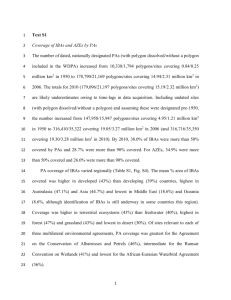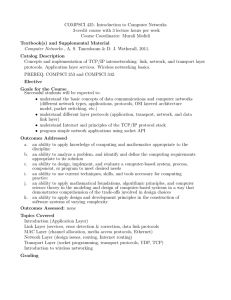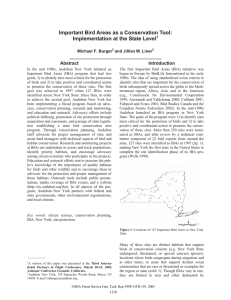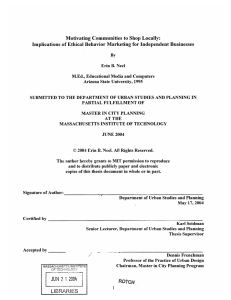Toward standards for dynamics in future electric energy systems— The basis for plug‐and‐play industry paradigm
advertisement
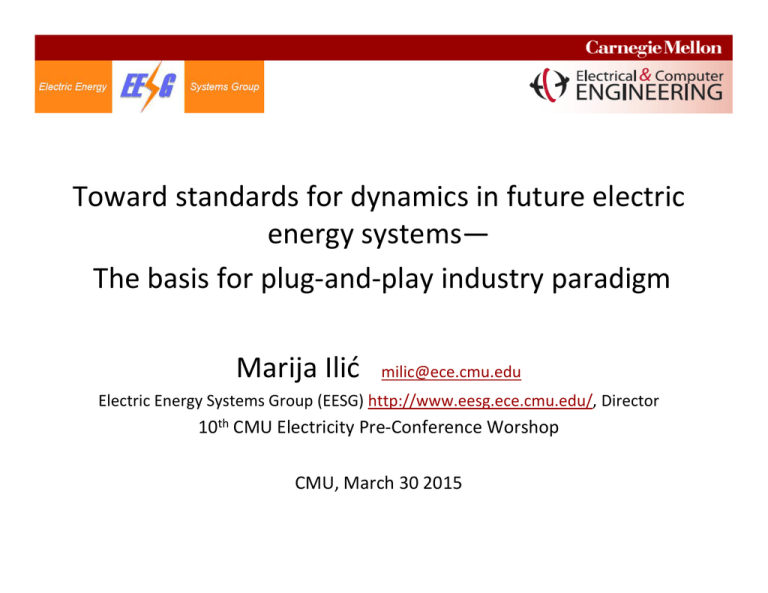
Toward standards for dynamics in future electric energy systems— The basis for plug‐and‐play industry paradigm Marija Ilić milic@ece.cmu.edu Electric Energy Systems Group (EESG) http://www.eesg.ece.cmu.edu/, Director 10th CMU Electricity Pre‐Conference Worshop CMU, March 30 2015 Outline Overview of current NERC standards and evolving standards for wind and solar plants Issues with current standards Our proposal : Plug-and-play (TCP/IP) like protocols/standards Introduction of intelligent Balancing Authority (iBAs) Examples of iBAs Theoretical foundations for new standards (TCP/IP like) Proof-of-concept examples of controller designs which meet such protocols NERC standards Transmission Planning Standards - System simulations and associated assessments are needed periodically to ensure that reliable systems are developed that meet specified performance ( http://www.nerc.com) Category Contingencies System Stable and both Thermal and Voltage Limits within Applicable Rating Loss of Demand A No contingency Yes No B Event resulting in the loss of a single element. Yes No C Event(s) resulting in the loss of two or more (multiple) elements. Yes D Extreme event resulting in two or more (multiple) elements removed or Cascading out of service. Planned/ Controlled Evaluate for risks and Consequences. - May involve substantial loss of customer Demand and generation in a widespread area or areas. - Portions or all of the interconnected systems may or may not achieve a new, stable operating point. -Evaluation of these events may require joint studies with neighboring systems. 3 Evolving standards for Wind and Solar Generation Technologies • voltage/var control/regulation • voltage ride‐through • power curtailment and ramping • primary frequency regulation • inertial response http://www.nerc.com/files/2012_IVGTF_Task_1-3.pdf NERC 2012 Special Assessment: Interconnection Requirements for Variable Generation September 2012 4 Need for a new paradigm Today’s industry approach– the worst case approach, inefficient and does not rely on on‐line automation and regulation other than energy feed‐ forward economic dispatch Emphasis on large‐scale time‐domain system simulations for transient stability, voltage, collapse, power flow feasibility, etc Primary control is constant gain tuned assuming no dynamic interactions with the rest of the system Existing and emerging system‐level unacceptable interactions; no incentives for ``smarts” of modules Information exchange in the case of Flores‐‐‐new (lots of dynamic control and sensing) Transmission grid PMU DSO DSO DSO Module PMU SVC Power-electronics Module Phasor Measurement Units Dynamic Purpose Communication Market and Equipment Status Communication Possible dynamical problems seen by particular dynamic components Dynamical problems Small signal instab. Types of Component Synchronous generators ? Wind generators ? Solar plants Transient instab. SS R ? SSCI Freq. Volt. Power flow instab. Instab. imbalance ? ? ? ? ? ? ? ? ? ? ? ? ? ? ? ? ? ? FACTS ? ? ? ? ? ? ? Storage ? ? ? ? ? ? ? Table 1. 7 Our proposal: TCP/IP like standards Given specified disturbances and range of operating conditions within a known system: ‐ specified with e.g voltage, power ‐ similar to LVRT curves for wind turbines ‐ with specified duration All components (synchronous gens, wind gens) should guarantee that they would not create any of the problems in Table 1. (Clear objectives goals for components, assigned responsibility for system reliability) Two key questions: Q1‐‐ Why does it matter? Q2)‐‐‐ Can this be technically done? Not one way to achieve these! 8 Not one way to meet the standards -iBAs iBAs (intelligent Balancing Authorities) Single component or group of components which meet the desired objectives: Given specified disturbances their components do not cause any of the dynamical problems in Table 1. Dynamic notion of Control Areas—intelligent Balancing Authorities (iBAs) iBAs would utilize advanced control design methods to meet the protocol; could be either decentralized or wide area control (cooperative control to save on number of controllers and energy used within the iBA) Huge potential for exploiting efficiently new technologies like storage and FACTS and at the same time have guaranteed system performance S.Baros, M.Ilic intelligent Balancing Authorities (iBAs) for Transient Stabilization of Large Power Systems IEEE PES General Meeting 2014 9 A1: Examples of iBAs—it matters for ensuring both reliable and efficient operations iBA 1 iBA 3 Storage iBA 2 10 Possible to create iBAs for meeting transient stability distributed standard 18 21 22 17 16 Given disturbance Tripping of generator 1 20 19 15 14 13 11 24 23 12 iBA 3 9 10 6 4 5 8 1 2 7 S.Baros, M.Ilic intelligent Balancing Authorities (iBAs) for Transient Stabilization of Large Power Systems IEEE PES General Meeting 2014 11 Rotor angle response of iBA generators 12 Q2: Can we have a unifying theoretically sound approach to TCP/IP like standards for smart grids? Basic functionalities Simple transparent TCP/IP like functionalities Transparency based on a unifying modular modeling of network system dynamics Provable performance‐difficult Proposal—use interaction variables to specify family of standards sufficient to avoid operating problems Measure of how well modules balance themselves in steady state Measure of rate of exchange of stored energy between a module and the rest of the system over different time horizons 14 Unifying modeling and control approach— use of multi‐scale interaction variables Standards/protocols ‐‐‐ specifications of module interactions for plug‐and‐play operations; architectures define how are sets of protocols organized Cyber design for managing multi‐layered interactions New physics‐based modeling and control as the basis for interaction variables‐based protocols Illustrations of possible standards‐based enhancements (transient stabilization using power electronics switching; storage control in micro‐grids) Must simplify as much as possible, but not more! Utilities are having hard time adding all these new components and their smarts for simulating system‐wide dynamics Is there a ``smarter” way to model and define modular functionalities so that the interconnected system meets system‐level performance (Table 1)? 80% of each solution is modeling (Petar Kokotovic, Chalenges in Control Theory, Santa Clara, circa 1982) 16 Conclusions Our proposal: Interaction variable-based Rigorous way to minimize information exchange among distributed entities Standards/protocols for interactive iBAs can set the basis for plug-and-play in smart grids—bounds on stored energy change and on rate of change of stored energy for T of interest Standards need to define transparent protocols for all dynamic components Complexity of smart grids can be managed this way At the same time system performance is guaranteed With current NERC standards system performance cannot be mapped into responsibilities of different components 17



